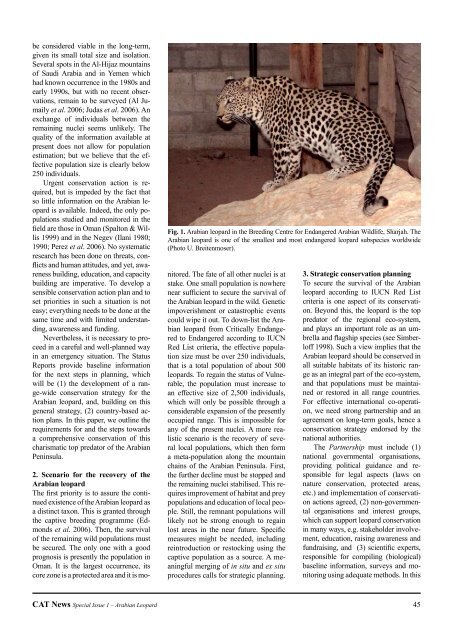Status and Conservation of the Leopard on the Arabian Peninsula ...
Status and Conservation of the Leopard on the Arabian Peninsula ...
Status and Conservation of the Leopard on the Arabian Peninsula ...
Create successful ePaper yourself
Turn your PDF publications into a flip-book with our unique Google optimized e-Paper software.
e c<strong>on</strong>sidered viable in <str<strong>on</strong>g>the</str<strong>on</strong>g> l<strong>on</strong>g-term,<br />
given its small total size <str<strong>on</strong>g>and</str<strong>on</strong>g> isolati<strong>on</strong>.<br />
Several spots in <str<strong>on</strong>g>the</str<strong>on</strong>g> Al-Hijaz mountains<br />
<str<strong>on</strong>g>of</str<strong>on</strong>g> Saudi Arabia <str<strong>on</strong>g>and</str<strong>on</strong>g> in Yemen which<br />
had known occurrence in <str<strong>on</strong>g>the</str<strong>on</strong>g> 1980s <str<strong>on</strong>g>and</str<strong>on</strong>g><br />
early 1990s, but with no recent observati<strong>on</strong>s,<br />
remain to be surveyed (Al Jumaily<br />
et al. 2006; Judas et al. 2006). An<br />
exchange <str<strong>on</strong>g>of</str<strong>on</strong>g> individuals between <str<strong>on</strong>g>the</str<strong>on</strong>g><br />
remaining nuclei seems unlikely. The<br />
quality <str<strong>on</strong>g>of</str<strong>on</strong>g> <str<strong>on</strong>g>the</str<strong>on</strong>g> informati<strong>on</strong> available at<br />
present does not allow for populati<strong>on</strong><br />
estimati<strong>on</strong>; but we believe that <str<strong>on</strong>g>the</str<strong>on</strong>g> effective<br />
populati<strong>on</strong> size is clearly below<br />
250 individuals.<br />
Urgent c<strong>on</strong>servati<strong>on</strong> acti<strong>on</strong> is required,<br />
but is impeded by <str<strong>on</strong>g>the</str<strong>on</strong>g> fact that<br />
so little informati<strong>on</strong> <strong>on</strong> <str<strong>on</strong>g>the</str<strong>on</strong>g> <strong>Arabian</strong> leopard<br />
is available. Indeed, <str<strong>on</strong>g>the</str<strong>on</strong>g> <strong>on</strong>ly populati<strong>on</strong>s<br />
studied <str<strong>on</strong>g>and</str<strong>on</strong>g> m<strong>on</strong>itored in <str<strong>on</strong>g>the</str<strong>on</strong>g><br />
field are those in Oman (Spalt<strong>on</strong> & Willis<br />
1999) <str<strong>on</strong>g>and</str<strong>on</strong>g> in <str<strong>on</strong>g>the</str<strong>on</strong>g> Negev (Ilani 1980;<br />
1990; Perez et al. 2006). No systematic<br />
research has been d<strong>on</strong>e <strong>on</strong> threats, c<strong>on</strong>flicts<br />
<str<strong>on</strong>g>and</str<strong>on</strong>g> human attitudes, <str<strong>on</strong>g>and</str<strong>on</strong>g> yet, awareness<br />
building, educati<strong>on</strong>, <str<strong>on</strong>g>and</str<strong>on</strong>g> capacity<br />
building are imperative. To develop a<br />
sensible c<strong>on</strong>servati<strong>on</strong> acti<strong>on</strong> plan <str<strong>on</strong>g>and</str<strong>on</strong>g> to<br />
set priorities in such a situati<strong>on</strong> is not<br />
easy; everything needs to be d<strong>on</strong>e at <str<strong>on</strong>g>the</str<strong>on</strong>g><br />
same time <str<strong>on</strong>g>and</str<strong>on</strong>g> with limited underst<str<strong>on</strong>g>and</str<strong>on</strong>g>ing,<br />
awareness <str<strong>on</strong>g>and</str<strong>on</strong>g> funding.<br />
Never<str<strong>on</strong>g>the</str<strong>on</strong>g>less, it is necessary to proceed<br />
in a careful <str<strong>on</strong>g>and</str<strong>on</strong>g> well-planned way<br />
in an emergency situati<strong>on</strong>. The <str<strong>on</strong>g>Status</str<strong>on</strong>g><br />
Reports provide baseline informati<strong>on</strong><br />
for <str<strong>on</strong>g>the</str<strong>on</strong>g> next steps in planning, which<br />
will be (1) <str<strong>on</strong>g>the</str<strong>on</strong>g> development <str<strong>on</strong>g>of</str<strong>on</strong>g> a range-wide<br />
c<strong>on</strong>servati<strong>on</strong> strategy for <str<strong>on</strong>g>the</str<strong>on</strong>g><br />
<strong>Arabian</strong> leopard, <str<strong>on</strong>g>and</str<strong>on</strong>g>, building <strong>on</strong> this<br />
general strategy, (2) country-based acti<strong>on</strong><br />
plans. In this paper, we outline <str<strong>on</strong>g>the</str<strong>on</strong>g><br />
requirements for <str<strong>on</strong>g>and</str<strong>on</strong>g> <str<strong>on</strong>g>the</str<strong>on</strong>g> steps towards<br />
a comprehensive c<strong>on</strong>servati<strong>on</strong> <str<strong>on</strong>g>of</str<strong>on</strong>g> this<br />
charismatic top predator <str<strong>on</strong>g>of</str<strong>on</strong>g> <str<strong>on</strong>g>the</str<strong>on</strong>g> <strong>Arabian</strong><br />
<strong>Peninsula</strong>.<br />
2. Scenario for <str<strong>on</strong>g>the</str<strong>on</strong>g> recovery <str<strong>on</strong>g>of</str<strong>on</strong>g> <str<strong>on</strong>g>the</str<strong>on</strong>g><br />
<strong>Arabian</strong> leopard<br />
The first priority is to assure <str<strong>on</strong>g>the</str<strong>on</strong>g> c<strong>on</strong>tinued<br />
existence <str<strong>on</strong>g>of</str<strong>on</strong>g> <str<strong>on</strong>g>the</str<strong>on</strong>g> <strong>Arabian</strong> leopard as<br />
a distinct tax<strong>on</strong>. This is granted through<br />
<str<strong>on</strong>g>the</str<strong>on</strong>g> captive breeding programme (Edm<strong>on</strong>ds<br />
et al. 2006). Then, <str<strong>on</strong>g>the</str<strong>on</strong>g> survival<br />
<str<strong>on</strong>g>of</str<strong>on</strong>g> <str<strong>on</strong>g>the</str<strong>on</strong>g> remaining wild populati<strong>on</strong>s must<br />
be secured. The <strong>on</strong>ly <strong>on</strong>e with a good<br />
prognosis is presently <str<strong>on</strong>g>the</str<strong>on</strong>g> populati<strong>on</strong> in<br />
Oman. It is <str<strong>on</strong>g>the</str<strong>on</strong>g> largest occurrence, its<br />
core z<strong>on</strong>e is a protected area <str<strong>on</strong>g>and</str<strong>on</strong>g> it is mo-<br />
Fig. 1. <strong>Arabian</strong> leopard in <str<strong>on</strong>g>the</str<strong>on</strong>g> Breeding Centre for Endangered <strong>Arabian</strong> Wildlife, Sharjah. The<br />
<strong>Arabian</strong> leopard is <strong>on</strong>e <str<strong>on</strong>g>of</str<strong>on</strong>g> <str<strong>on</strong>g>the</str<strong>on</strong>g> smallest <str<strong>on</strong>g>and</str<strong>on</strong>g> most endangered leopard subspecies worldwide<br />
(Photo U. Breitenmoser).<br />
nitored. The fate <str<strong>on</strong>g>of</str<strong>on</strong>g> all o<str<strong>on</strong>g>the</str<strong>on</strong>g>r nuclei is at<br />
stake. One small populati<strong>on</strong> is nowhere<br />
near sufficient to secure <str<strong>on</strong>g>the</str<strong>on</strong>g> survival <str<strong>on</strong>g>of</str<strong>on</strong>g><br />
<str<strong>on</strong>g>the</str<strong>on</strong>g> <strong>Arabian</strong> leopard in <str<strong>on</strong>g>the</str<strong>on</strong>g> wild. Genetic<br />
impoverishment or catastrophic events<br />
could wipe it out. To down-list <str<strong>on</strong>g>the</str<strong>on</strong>g> <strong>Arabian</strong><br />
leopard from Critically Endangered<br />
to Endangered according to IUCN<br />
Red List criteria, <str<strong>on</strong>g>the</str<strong>on</strong>g> effective populati<strong>on</strong><br />
size must be over 250 individuals,<br />
that is a total populati<strong>on</strong> <str<strong>on</strong>g>of</str<strong>on</strong>g> about 500<br />
leopards. To regain <str<strong>on</strong>g>the</str<strong>on</strong>g> status <str<strong>on</strong>g>of</str<strong>on</strong>g> Vulnerable,<br />
<str<strong>on</strong>g>the</str<strong>on</strong>g> populati<strong>on</strong> must increase to<br />
an effective size <str<strong>on</strong>g>of</str<strong>on</strong>g> 2,500 individuals,<br />
which will <strong>on</strong>ly be possible through a<br />
c<strong>on</strong>siderable expansi<strong>on</strong> <str<strong>on</strong>g>of</str<strong>on</strong>g> <str<strong>on</strong>g>the</str<strong>on</strong>g> presently<br />
occupied range. This is impossible for<br />
any <str<strong>on</strong>g>of</str<strong>on</strong>g> <str<strong>on</strong>g>the</str<strong>on</strong>g> present nuclei. A more realistic<br />
scenario is <str<strong>on</strong>g>the</str<strong>on</strong>g> recovery <str<strong>on</strong>g>of</str<strong>on</strong>g> several<br />
local populati<strong>on</strong>s, which <str<strong>on</strong>g>the</str<strong>on</strong>g>n form<br />
a meta-populati<strong>on</strong> al<strong>on</strong>g <str<strong>on</strong>g>the</str<strong>on</strong>g> mountain<br />
chains <str<strong>on</strong>g>of</str<strong>on</strong>g> <str<strong>on</strong>g>the</str<strong>on</strong>g> <strong>Arabian</strong> <strong>Peninsula</strong>. First,<br />
<str<strong>on</strong>g>the</str<strong>on</strong>g> fur<str<strong>on</strong>g>the</str<strong>on</strong>g>r decline must be stopped <str<strong>on</strong>g>and</str<strong>on</strong>g><br />
<str<strong>on</strong>g>the</str<strong>on</strong>g> remaining nuclei stabilised. This requires<br />
improvement <str<strong>on</strong>g>of</str<strong>on</strong>g> habitat <str<strong>on</strong>g>and</str<strong>on</strong>g> prey<br />
populati<strong>on</strong>s <str<strong>on</strong>g>and</str<strong>on</strong>g> educati<strong>on</strong> <str<strong>on</strong>g>of</str<strong>on</strong>g> local people.<br />
Still, <str<strong>on</strong>g>the</str<strong>on</strong>g> remnant populati<strong>on</strong>s will<br />
likely not be str<strong>on</strong>g enough to regain<br />
lost areas in <str<strong>on</strong>g>the</str<strong>on</strong>g> near future. Specific<br />
measures might be needed, including<br />
reintroducti<strong>on</strong> or restocking using <str<strong>on</strong>g>the</str<strong>on</strong>g><br />
captive populati<strong>on</strong> as a source. A meaningful<br />
merging <str<strong>on</strong>g>of</str<strong>on</strong>g> in situ <str<strong>on</strong>g>and</str<strong>on</strong>g> ex situ<br />
procedures calls for strategic planning.<br />
3. Strategic c<strong>on</strong>servati<strong>on</strong> planning<br />
To secure <str<strong>on</strong>g>the</str<strong>on</strong>g> survival <str<strong>on</strong>g>of</str<strong>on</strong>g> <str<strong>on</strong>g>the</str<strong>on</strong>g> <strong>Arabian</strong><br />
leopard according to IUCN Red List<br />
criteria is <strong>on</strong>e aspect <str<strong>on</strong>g>of</str<strong>on</strong>g> its c<strong>on</strong>servati<strong>on</strong>.<br />
Bey<strong>on</strong>d this, <str<strong>on</strong>g>the</str<strong>on</strong>g> leopard is <str<strong>on</strong>g>the</str<strong>on</strong>g> top<br />
predator <str<strong>on</strong>g>of</str<strong>on</strong>g> <str<strong>on</strong>g>the</str<strong>on</strong>g> regi<strong>on</strong>al eco-system,<br />
<str<strong>on</strong>g>and</str<strong>on</strong>g> plays an important role as an umbrella<br />
<str<strong>on</strong>g>and</str<strong>on</strong>g> flagship species (see Simberl<str<strong>on</strong>g>of</str<strong>on</strong>g>f<br />
1998). Such a view implies that <str<strong>on</strong>g>the</str<strong>on</strong>g><br />
<strong>Arabian</strong> leopard should be c<strong>on</strong>served in<br />
all suitable habitats <str<strong>on</strong>g>of</str<strong>on</strong>g> its historic range<br />
as an integral part <str<strong>on</strong>g>of</str<strong>on</strong>g> <str<strong>on</strong>g>the</str<strong>on</strong>g> eco-system,<br />
<str<strong>on</strong>g>and</str<strong>on</strong>g> that populati<strong>on</strong>s must be maintained<br />
or restored in all range countries.<br />
For effective internati<strong>on</strong>al co-operati<strong>on</strong>,<br />
we need str<strong>on</strong>g partnership <str<strong>on</strong>g>and</str<strong>on</strong>g> an<br />
agreement <strong>on</strong> l<strong>on</strong>g-term goals, hence a<br />
c<strong>on</strong>servati<strong>on</strong> strategy endorsed by <str<strong>on</strong>g>the</str<strong>on</strong>g><br />
nati<strong>on</strong>al authorities.<br />
The Partnership must include (1)<br />
nati<strong>on</strong>al governmental organisati<strong>on</strong>s,<br />
providing political guidance <str<strong>on</strong>g>and</str<strong>on</strong>g> resp<strong>on</strong>sible<br />
for legal aspects (laws <strong>on</strong><br />
nature c<strong>on</strong>servati<strong>on</strong>, protected areas,<br />
etc.) <str<strong>on</strong>g>and</str<strong>on</strong>g> implementati<strong>on</strong> <str<strong>on</strong>g>of</str<strong>on</strong>g> c<strong>on</strong>servati<strong>on</strong><br />
acti<strong>on</strong>s agreed, (2) n<strong>on</strong>-governmental<br />
organisati<strong>on</strong>s <str<strong>on</strong>g>and</str<strong>on</strong>g> interest groups,<br />
which can support leopard c<strong>on</strong>servati<strong>on</strong><br />
in many ways, e.g. stakeholder involvement,<br />
educati<strong>on</strong>, raising awareness <str<strong>on</strong>g>and</str<strong>on</strong>g><br />
fundraising, <str<strong>on</strong>g>and</str<strong>on</strong>g> (3) scientific experts,<br />
resp<strong>on</strong>sible for compiling (biological)<br />
baseline informati<strong>on</strong>, surveys <str<strong>on</strong>g>and</str<strong>on</strong>g> m<strong>on</strong>itoring<br />
using adequate methods. In this<br />
CAT News Special Issue 1 – <strong>Arabian</strong> <str<strong>on</strong>g>Leopard</str<strong>on</strong>g> 45


